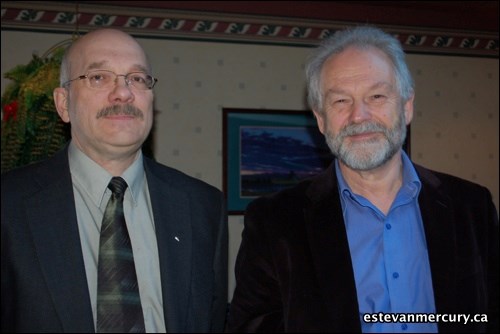The Estevan business community took advantage of an excellent opportunity to get a first-hand report on major projects taking place on the city's doorstep when Malcolm Wilson and Douglas Nixon attended the Estevan Chamber of Commerce monthly business meeting.
The two men were later joined by a cadre of various industry experts at an open house event at the Saskatchewan Energy Training Institute (SETI) which shed even more light on the SaskPower carbon capture project at Boundary Dam Power Station, the nearby carbon dioxide sequestration project Aquistore, which is under the direction of the Petroleum Technology Research Centre (PTRC) and the SaskPower test facility at Shand Power Station.
Wilson, the CEO of PTRC, focused mainly on the Aquistore project for the 50 or more C of C members at Allie's Restaurant for the noon luncheon meeting. Nixon, associate manager of the clean coal project at Boundary, gave an update on that $1.24 billion project and the two along with geologists, communication officers, pipeline engineers and others joined forces to provide the general public attending the open house with information regarding all three projects.
Wilson said the carbon dioxide capture and sequestration project, which is quickly gaining steam, has captured world-wide attention since it is now the only one with any real cache and momentum.
"This is it, this is the ground floor. Europe's attempt to build a project is a shipwreck now, Alberta's and B.C.'s projects have slowed as has America's," he said.
As a result, the carbon dioxide capture project at Unit No. 3 at Boundary Dam (BD3), which is nearly 50 per cent completed, is the only credible commercial-sized project on the board right now, the two men said.
Nixon said the BD3 project has gained all the expertise required for the installation of the equipment that will be used to capture the CO2.
Wilson pointed out that the in-ground storage site has been identified in nearby property owned by SaskPower. The storage for the CO2 will be in cavern-like structures, 3.4 kilometres underground which is well below deep wells and any other drilling or mining zones with heavy shale and saline (salt) serving as nature's sealants that will prevent any unexpected leakages.
Wilson said Aquistore has received $22.3 million from sponsorship partners for the project that "will prove that the process is safe. And there is more experience here than anywhere else in the world to carry out the demonstration and evaluation."
Wilson said the risk assessment has been completed. Testing and observation will now follow with about 2,000 tonnes of imported carbon dioxide gas to be carried in for that purpose later this year in preparation for the CO2 that will come from BD3 in early 2014.
"We're using the Deadwood/Winnipeg formation which is well down, plus protected by a good salt zone, and salt is the great barrier because it self-heals and closes the formation," said Wilson.
Fixed and multiple seismic surveys have been completed and ground water and soil gas baselines are being completed this month which will then make way for the first injection of the gas.
Storing CO2 underground is not new technology, said Wilson, noting that commercial sized operations have been tested around the world since 1996, including the familiar Goodwater/Weyburn field that has used carbon dioxide for enhanced oil recovery since 2000. He said the Weyburn area project is the largest in the world and more is known about it because it is an oil-based industry.
"Up to now, Weyburn has been the household word for CO2 storage, now it will be Estevan that will be popping up on the world maps with the commercial-sized capture, storage and test facilities. While other projects, like I said, are shipwrecks, ours is the one that is under construction and the people ... the experts are looking at this as a fully integrated project."
Nixon said Saskatchewan needed the carbon dioxide capture project because it was evident that coal was going to be the fuel that would feed the future power needs in Saskatchewan along with some other alternatives.
"The need was to minimize customer cost so this project got the green light in April of 2011 and most of the major contracts associated with it have been signed," Nixon said.
He said the BD3 project is being assessed economically on a very conservative assumption side and costs will decline as performance improvements are made through the life of the project using coal as a very cost-reliable fuel.
"The test facility at Shand will provide a neutral platform for vendors to verify and improve technological systems using an existing commercial operation," Nixon added.
The two men said that as the knowledge base grows, some of the information and intellectual properties will be shared openly with the world while other elements of the processes will only be available for a fee.
"It'll be for partners who want to learn from us for a fee, to receive training and management procedures and the information they'll need," said Nixon.
Wilson said that the Aquistore project has several working partnerships already in the form of corporations and countries that have expressed a desire to be in on the ground floor and were willing to pay for that privilege.




